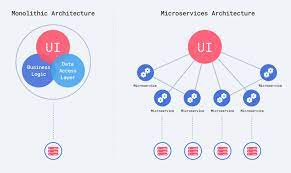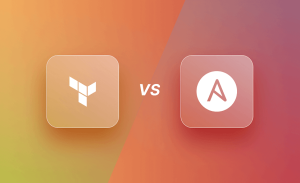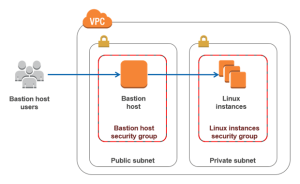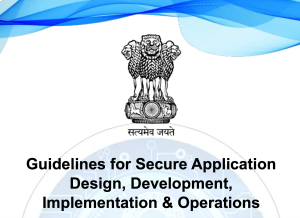
Monolithic and microservices are two architectural styles for designing and developing software applications.
- Monolithic Architecture: Monolithic architecture refers to building an application as a single, self-contained unit. In a monolithic architecture, all components of the application, such as the user interface, business logic, and data access layer, are tightly coupled and run as a single process. The entire application is typically deployed and scaled as a single unit.
Key characteristics of monolithic architecture include:
- Single, large codebase containing all functionalities.
- Tight coupling between components.
- Common technology stack and programming language.
- Shared database or data layer.
- Difficult to scale specific components independently.
- Changes to one part of the application may require rebuilding and redeploying the entire monolith.
- Microservices Architecture: Microservices architecture, on the other hand, decomposes an application into smaller, loosely coupled services that are independently deployable and scalable. Each service is responsible for a specific business capability and communicates with other services through well-defined APIs or protocols, often using lightweight mechanisms like HTTP or messaging.
Key characteristics of microservices architecture include:
- Application split into small, autonomous services.
- Loosely coupled services that can be developed and deployed independently.
- Services communicate over well-defined interfaces (APIs).
- Each service can have its own technology stack and database.
- Scalability and fault isolation at the service level.
- Rapid development cycles and continuous deployment.
- Easier adoption of new technologies and innovations.
- Complexities around service discovery, inter-service communication, and data consistency.
Microservices architecture offers advantages such as flexibility, scalability, independent development, and fault isolation. However, it also introduces complexities in terms of distributed systems, service coordination, and operational management.

Choosing between monolithic and microservices architectures depends on various factors such as the size and complexity of the application, development team structure, scalability requirements, and the need for independent deployment and technology choices. Each approach has its own trade-offs, and the decision should be based on the specific needs and goals of the application and the organization.
The decision to use microservices, a monolithic architecture, or a combination of both depends on various factors such as the complexity of the application, scalability requirements, development team size, deployment environment, and organizational goals. Let’s explore each approach:
- Monolithic Architecture:
- In a monolithic architecture, the entire application is developed as a single, tightly-coupled unit.
- Pros:
- Simplicity: Developing and deploying a monolithic application is generally simpler compared to a distributed architecture like microservices.
- Performance: Monolithic applications can have better performance as they avoid network communication overhead.
- Cons:
- Scalability: Scaling monolithic applications can be challenging as the entire application needs to be scaled rather than specific components.
- Flexibility: Making changes or introducing new technologies to a monolithic application can be more complex and time-consuming.
- Microservices Architecture:
- In a microservices architecture, the application is divided into a collection of small, loosely-coupled services that communicate with each other via APIs.
- Pros:
- Scalability: Each microservice can be independently scaled based on its specific needs, allowing for better scalability.
- Flexibility: Microservices enable teams to work independently on different services, using different technologies and making it easier to introduce new features or technologies.
- Fault Isolation: Failures in one microservice are less likely to impact the entire system as they are isolated.
- Cons:
- Complexity: Microservices introduce additional complexity in terms of service coordination, deployment, and monitoring.
- Communication Overhead: Communication between microservices adds network latency and can impact performance.
- Combination of Both:
- It is also possible to adopt a hybrid approach, where certain parts of the application are built as microservices while others remain within a monolithic architecture.
- Pros:
- Gradual Migration: A hybrid approach allows for a gradual migration from a monolithic architecture to microservices, reducing risks and enabling incremental improvements.
- Flexibility: The combination of both approaches provides flexibility to leverage the strengths of each approach based on specific requirements.
- Cons:
- Increased Complexity: Combining different architectures adds complexity in terms of integration and communication between monolithic and microservices components.
The choice between microservices, a monolithic architecture, or a combination depends on the specific needs and constraints of your project. It is important to carefully consider factors such as team expertise, project size and complexity, scalability requirements, and long-term goals to make an informed decision.
Advantages of Monoliths
Monolithic architectures, despite their limitations, offer several advantages in certain scenarios. Here are some advantages of monolithic architectures:
- Simplicity: Monolithic architectures are relatively simple compared to distributed architectures like microservices. The entire application is contained within a single codebase, making it easier to develop, test, and deploy.
- Development Efficiency: With a monolithic architecture, developers can work on the entire application without worrying about inter-service communication or managing multiple code repositories. This can lead to faster development cycles and quicker time to market.
- Performance: Monolithic architectures can offer better performance compared to distributed architectures since they avoid the overhead of inter-service communication. Direct method calls within the monolith can be more efficient than making API calls between services.
- Easier Debugging and Troubleshooting: In a monolithic architecture, it is easier to trace and debug issues since the application is contained within a single codebase. Developers can easily pinpoint the source of errors and troubleshoot them efficiently.
- Cost-Effective: Monolithic architectures require fewer resources and infrastructure compared to distributed architectures. There is no need to manage and scale multiple services or deal with the complexities of service orchestration.
- Deployment Simplicity: Deploying a monolithic application is typically simpler as it involves deploying a single artifact. There is no need to coordinate the deployment of multiple services or handle version compatibility between different components.
- Team Collaboration: Monolithic architectures promote tight collaboration within development teams as they work on a single codebase. Knowledge sharing, code reuse, and collaboration among team members are often easier in a monolithic setting.
- Compatibility: Monolithic architectures are compatible with a wide range of development frameworks and technologies. Developers can choose the most suitable tools and libraries for the entire application without worrying about compatibility issues between different services.
It’s important to note that the advantages of monolithic architectures may vary depending on the specific project requirements and the organization’s context. While monoliths offer simplicity and ease of development, they may pose challenges in terms of scalability, flexibility, and long-term maintenance. Careful consideration should be given to the specific needs of the project before deciding on the architecture approach.
Advantages of Microservices?
Microservices architecture offers several advantages that make it a popular choice for building complex and scalable applications. Here are some of the advantages of microservices:
- Modularity and Scalability: Microservices architecture breaks down an application into smaller, loosely coupled services. Each service focuses on a specific business capability, making it easier to develop, test, deploy, and scale independently. This modular approach allows organizations to scale individual services based on demand, ensuring optimal resource utilization.
- Independent Development and Deployment: Microservices enable independent development and deployment of each service. Development teams can work on different services simultaneously using different technologies and programming languages, based on the specific requirements of each service. This accelerates development cycles and promotes flexibility in technology choices.
- Fault Isolation and Resilience: In a microservices architecture, if one service fails or experiences issues, it doesn’t impact the entire system. Services are isolated from each other, enabling fault tolerance and resilience. Failures in one service are less likely to cascade and affect the overall application, improving system stability.
- Continuous Delivery and DevOps: Microservices align well with DevOps practices and continuous delivery. Each service can have its own deployment pipeline, allowing for faster and more frequent deployments. Teams can adopt independent release cycles, implement automated testing, and deploy updates to specific services without affecting others.
- Technology Diversity and Innovation: Microservices offer the flexibility to use different technologies, frameworks, and databases for each service. This allows organizations to leverage the best tools for specific tasks, promote innovation, and adopt new technologies without impacting the entire application.
- Scalability and Elasticity: Microservices architecture enables horizontal scaling by allowing individual services to scale independently based on their specific usage patterns. This approach optimizes resource allocation and improves overall application performance during high traffic periods.
- Team Autonomy and Ownership: Microservices promote team autonomy and ownership. Each service can be owned by a separate cross-functional team, responsible for its development, deployment, and maintenance. This empowers teams, improves accountability, and allows for faster decision-making.
- Fault Tolerance and Graceful Degradation: Microservices can be designed with fault tolerance and graceful degradation in mind. By using techniques like circuit breakers and fallback mechanisms, services can handle failures, maintain partial functionality, and gracefully degrade in the face of degraded or unavailable dependencies.
It’s important to note that microservices also introduce additional complexities, such as service discovery, inter-service communication, and data consistency across services. Proper design, architectural considerations, and operational management are essential to fully realize the benefits of microservices while mitigating the associated challenges.





